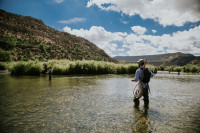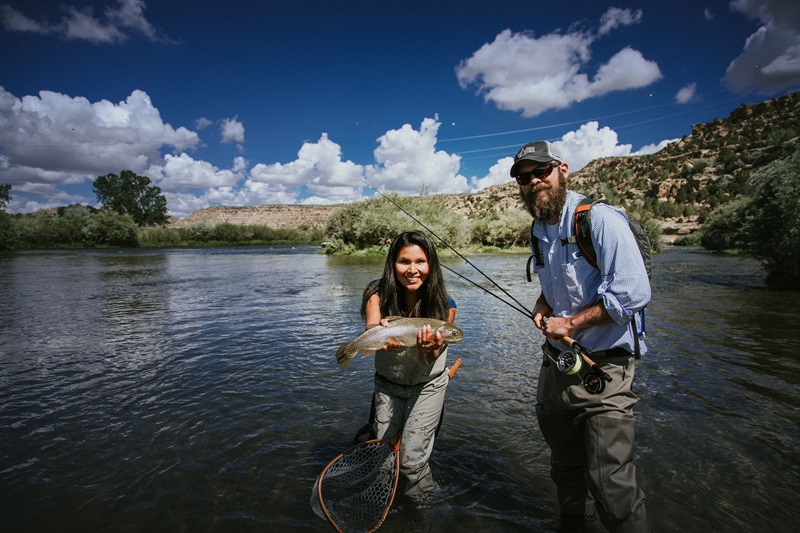

What makes the San Juan River so magical?
Starting in the mountains of southern Colorado and flowing into our corner of New Mexico before emptying into the Colorado River in southern Utah, the San Juan River is surrounded by one-of-a-kind nature, landscapes, and the preserved history of ancient Puebloan culture and beyond.

Whether just appreciating the beauty or taking part in the recreational activities it affords, the San Juan gives us and our visitors so much to love.
One part of what makes the San Juan River such a fantastic destination is that there isn’t any “bad” time of year to visit. There are certainly times that are notably more popular — summer for fishing, for example — but every season has so much to offer. The winter is milder than many close-by highlands and alpine areas, the spring brings the snow melt that gives the river an extra rush of energy, the summer is simply glorious, and fall brings with it changing colors and unique beauty. Many activities are popular year-round.
And then there’s…
The San Juan’s wildlife
Throughout the year, alongside the variety of fish, you’ll see different species of birds, both migratory and year-round, ranging from hawks to bluebirds to ospreys to swallows and families of geese.
Particularly unique is the American dipper, also known as the water ouzel, a cute aquatic songbird — North America’s only! — found in the mountainous regions of the western US and Canada. You’ll find these little guys enthusiastically jumping into the river, walking underwater in search of insects and larvae for prey, returning up to catch a moment or sing their song. It can be quite mesmerizing and wholesome taking a minute to watch them dive into the water and flit back and forth — these were John Muir’s favorite birds, after all. (Learn more about them on the Cornell Bird Lab’s page!)
You also might see some river-loving mammals on a trip down the San Juan, including beavers, tassel-eared squirrels with their distinctive tufts, and muskrats; elk, mule deer, pronghorn antelope, coyotes, and black bears abound too.
Just remember when it comes to nature and the wildlife around you to be respectful of your environment and leave everything as you found it. This means cleaning up after yourself and not being destructive in any way with your camping or activities.
Equally crucially, it means keeping your distance from wildlife and using common sense when it comes to food storage — both for your safety and the safety of the animals that call this area home. “A fed bear is a dead bear” goes for all wild species — make sure to respect them on your visit to keep the animals thriving and the area pristine.
Hiking and exploring the San Juan’s riverbanks
In many ways, everyone who comes to the San Juan River is there for the beauty and nature, it’s just a matter of what activity is the vehicle for experiencing it. Hiking and camping (more on that in a moment) is a great way to experience this with all your senses (well, except maybe taste).
As one of the Colorado River’s main tributaries, the San Juan River goes on for quite a while so has nearly endless hiking opportunities along the way along with places to get out and explore. In the stretch near where we are in Farmington is the Navajo Lake State Park, for example, which has lots of activities, and picnic and camping spots.
From its start in southern Colorado through New Mexico and onto Utah where it feeds into the Colorado River shortly before carving through the Grand Canyon in Arizona, there really are so many places to explore. This ranges from long, difficult hikes with scenic views to more mellow walks along the riverbank getting up close to the flora where you can hear and see some birds, lizards, and other critters.
You’ll also find ancient petroglyphs and ancestral Puebloan rock art carved into the canyonside at various points along the river. Some of this art is from more than 3,000 years ago from the Basketmaker culture, to 500 to 1,300 years old through until the ancestral Puebloans, but some panels are as recent as only 300 years old, drawn by the Ute and Navajo who still call the Four Corners region home.
Fishing the San Juan — a fly fisher’s dream
As much as for anything else, people come to the San Juan to fish. Most of all, they come for fly fishing, with especially legendary runs of rainbow and brown trout.
A great part of this river is that you can fish it year-round, with the conditions and appeal changing seasonally. Spring is when the insect hatches awaken a surge of fish, summer brings the most popular time of year, fall with the blast of changing colors, and winter has fewer crowds but surprisingly good fishing conditions given the relatively consistent water temperature.
You won’t just find trout, however. Take Navajo Lake State Park, for example, where there are also Kokanee salmon, bigmouth and smallmouth bass, crappie, northern pike, bluegill, and even catfish. The Navajo Lake Marina also includes other amenities for your visit, too.
Just downstream of Navajo Lake and its dam is the 3.75 mile-long Special Trout Waters — also known as “Quality Waters,” known for exactly what that name implies given the outflow of water from the Navajo Dam, which creates nutrient-rich, perfect conditions for fish-friendly insects and, you guessed it, fish.
This fantastic stretch of the San Juan is strictly catch and release only, requiring barbless hooks and flies or artificial lures. Just a few miles downstream of that is the Majestic Enchantment Fly Fishing spot, also a favorite, with the Soaring Eagle Lodge nearby. While the whole of the San Juan is a good destination for fishing, Quality Waters is popular for a reason — the fishing is pretty, pretty, pretty good.
Rafting and kayaking a paddling paradise (and hopping in for a swim)
Fishing isn’t all you can do on the water — people come from all over to paddle, canoe, and raft down the San Juan too.
Throughout the nearly 400 miles it spans, you’ll find everything from calm, easygoing flows for a relaxing float to thrilling rapids for experienced adventure seekers. There are also river rafting guides available or you can do it yourself.
Paddling the San Juan gives you beautiful landscapes that change at each turn, along with riverside cliffs and sandbars where you can pull up, have a picnic, and go for a swim. Depending on what you’re looking for, you’ll find different stretches of the river and times of year will suit your preferences better. For example, May and June are popular times for more intense paddling, when the flows pick up from the end of winter melt; on the flip side, you’ll want to hold off for a month or two if you’re less experienced with faster waters or just want a less intense, more relaxing float.
The most important things when it comes to paddling or rafting the river are:
- Educate yourself
- Know your level
- Be prepared
Failure to do so will not only set you up for a bad time, but could lead you into unsafe situations, injury, or worse.
Be honest with yourself about your and your party’s experience and ability level, your knowledge of the area, and how intensely you want to work. Don’t wander half-hazardly into a class five rapid. We cannot emphasize enough the importance of acknowledging the limit of your abilities and expertise, and choosing river conditions that align with that.
And, even if you are an experienced paddler, a guide can be an ideal resource to that end — not only will their local knowledge help you find the right waters for your abilities, but they’ll also just help you find the most fun waters.
Regardless of if you’re a novice or an expert, are going yourself or hiring a guide, educate yourself on the conditions and be prepared: Check river conditions and current flow rates, which you can do on the USGS website.
Camping by the river, sleeping under the stars
Of course, whether paddling, hiking, or just wanting to get immersed in nature, the San Juan provides an inimitable backdrop for spending the night outside.
Just like the rest of your time at the river, it’s important to leave no trace, be respectful, and camp in the right spot for your setup.
Besides obviously cleaning up after yourself and not disrupting the environment, know which rules are in place for the campsite and/or time of year. Certain stretches may have a fire ban, for example, which must be adhered to.
Once you know which kind of campsite you’re looking for, you can reserve one on the New Mexico State Parks reservation webpage. This tool also helps you find sites for different uses — alongside tent camping, you can filter for campervan- or horse-friendly sites, among other characteristics.
Last thoughts: Safety and final tips
The most important thing when visiting the river is being prepared and packing right.
The specifics differ depending on your chosen activities, but you may have to know the water conditions, the weather reports, and other factors that could impact your party’s safety. Weather can change pretty quickly and present a safety hazard if you’re not dressed appropriately and prepared. Winds at certain times of year can be unexpectedly brutal, for example.
Wear appropriate clothing and bring a change that can be layered or replace your current outfit. If you’re going to be getting wet and there’s even the slightest chance of weather cooling, make sure the closest layer to your skin isn’t cotton. Bring appropriate accessories and tools. Bring enough water. And always have basic first aid materials.
If you do all that — educate yourself, be prepared, pack appropriately, and know your abilities — you’re guaranteed to have a great time on our river.
Hope to see you soon!
